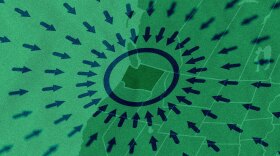The Puget Sound region won’t be the best place to take in the lunar eclipse in the wee hours of Tuesday morning. High clouds are likely to obscure the so-called “blood moon,” which flushes reddish in the shadow of the Earth.
University of Washington atmospheric scientist Cliff Mass says the northwest Washington coast might fare better. And cloud breaks might give even Seattle-area moon-gazers a glimpse — if they keep looking.
“That’s probably the most important advice I could give people is: if you don’t see it at one time, go back out there 15 minutes later, and you may be lucky,” he said. (You can check out the forecast models and an explanation of the physics on Mass’ blog.)
Unlike other astronomical events, a lunar eclipse is perfectly visible from most urban areas. The full eclipse will take place from about midnight to 1 a.m., as the Earth passes directly in between the sun and the moon. The reddish color comes from sunlight being filtered by the earth’s atmosphere – the same phenomenon that makes sunsets red.







